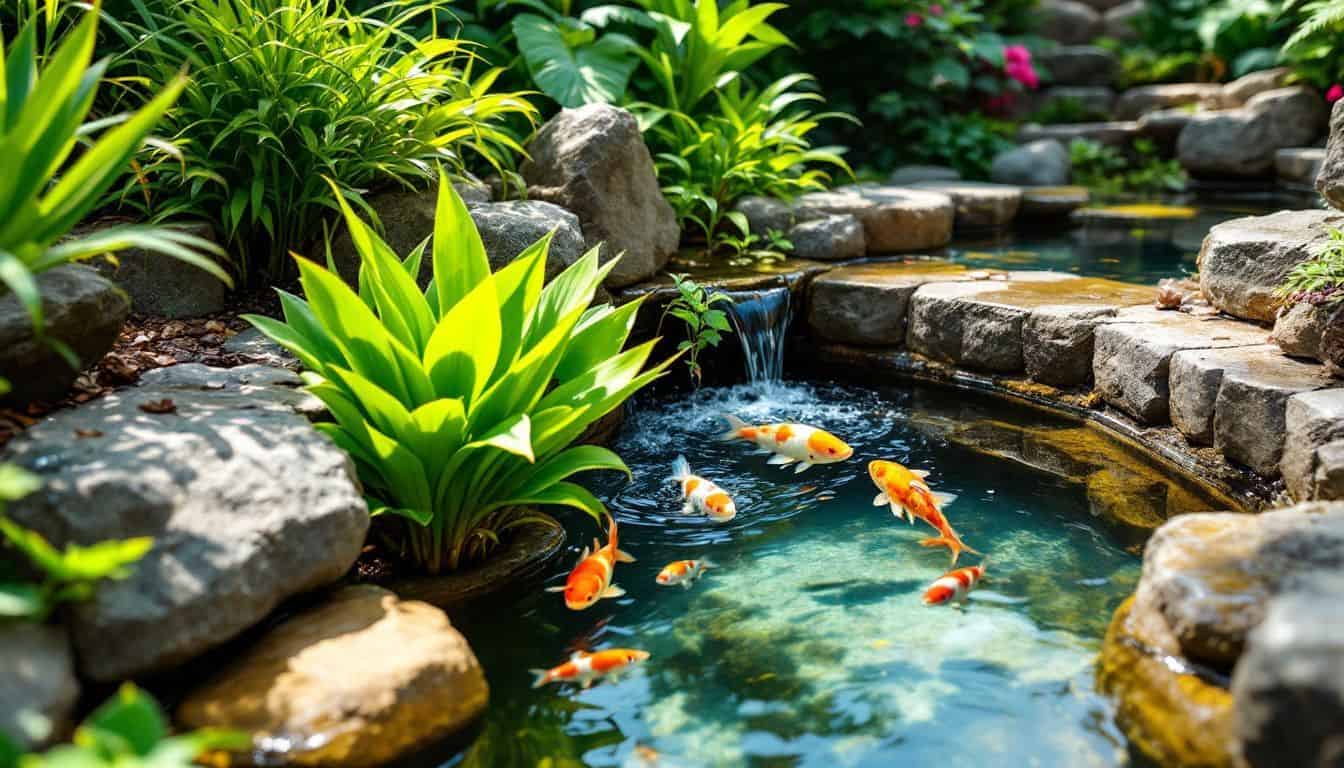Are you tired of your dull backyard? What is a water garden, you ask? It’s a magical oasis right in your own yard! Water gardens blend plants, water, and sometimes fish to create a peaceful spot.
This guide will show you how to make your own water garden in 8 easy steps. Ready to dive in?
Key Takeaways
Water gardens are shallow pools (under 20 inches deep) with aquatic plants and sometimes fish, costing between $3,680 to $14,500 to create.
Key components include containers (like teacups, barrels, or pots), water pumps for circulation, and water features like fountains or waterfalls.
Ideal plants include floating plants for shade, oxygenating plants to filter water, marginal plants for edges, and bog plants to absorb nutrients.
Fish like goldfish, koi, and mosquito fish can be added but need proper acclimation and at least 15 inches of water depth.
Regular maintenance involves removing debris, promoting plant growth, preparing for winter, and controlling algae to keep the water garden healthy.
Table of Contents
Understanding Water Gardens
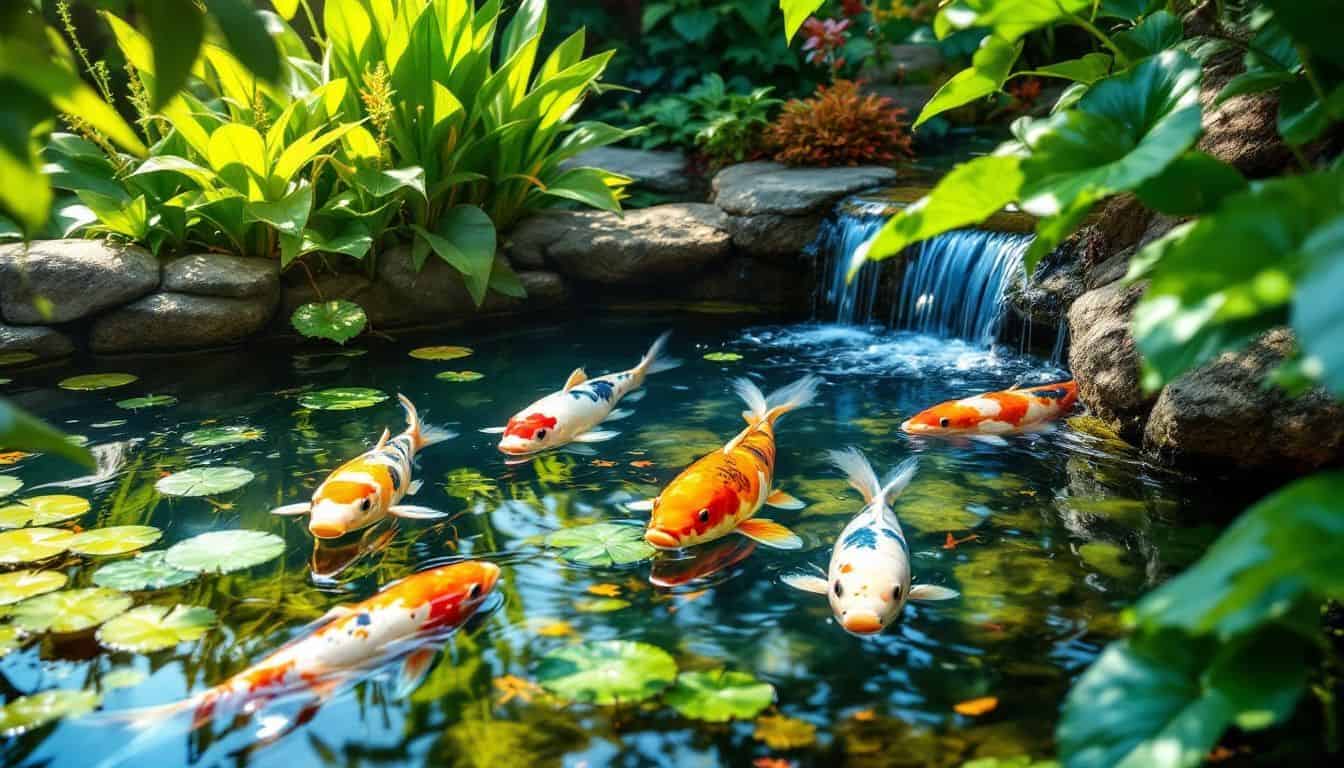
Water gardens are like mini oases in your backyard. They’re shallow pools – usually less than 20 inches deep – filled with aquatic plants and sometimes fish. These gardens have been around for ages, dating back to ancient Persian and Chinese cultures.
Today, they’re a hit with plant lovers and folks who want a slice of nature at home.
Creating a water garden isn’t cheap, but it’s worth it. Costs can range from $3,680 to $14,500, depending on how big you go. You’ve got options too – from simple containers to fancy PVC liners.
Some people even bring the magic indoors! The best part? Water gardens are perfect for sensitive plants that need special care.
A water garden is like a living painting, always changing with the seasons.
Key Components of a Water Garden
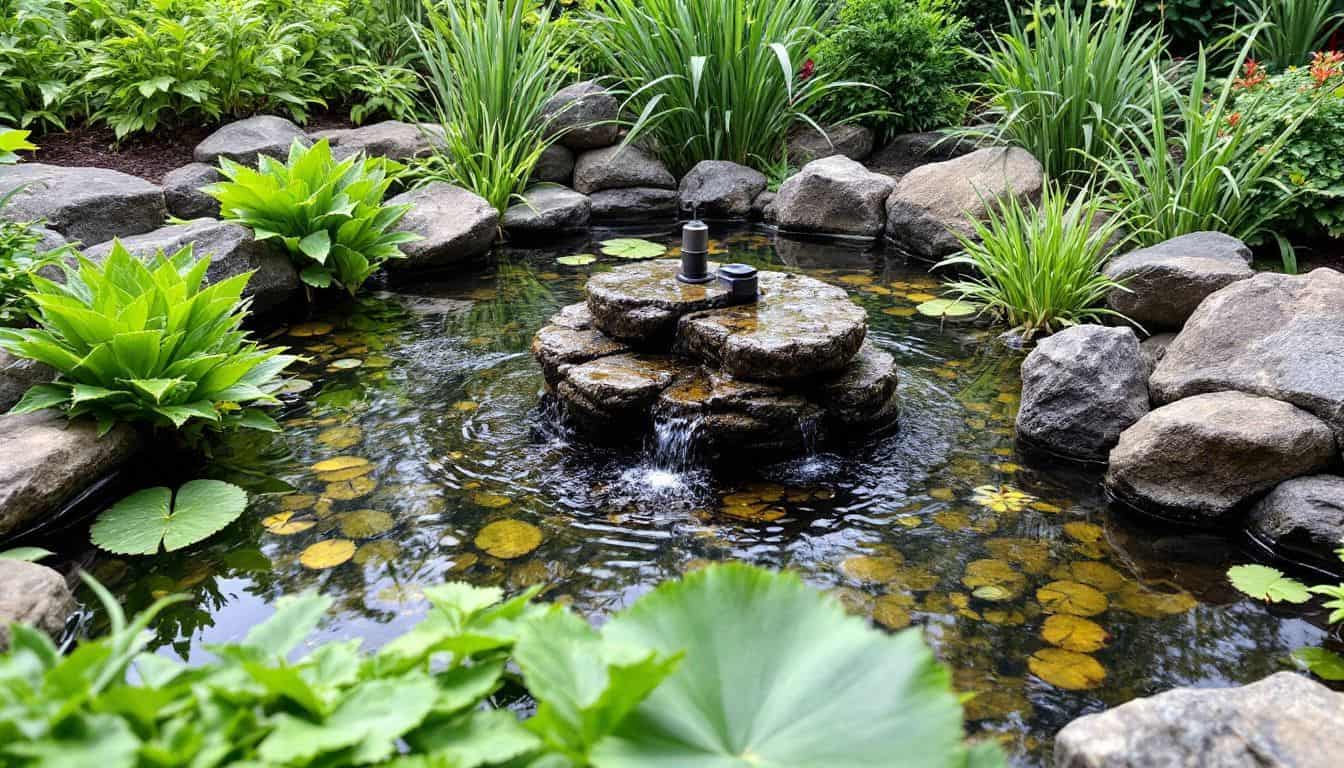
Water gardens are like puzzles. You need the right pieces to make them work. From pumps to plants, each part plays a role in creating your backyard oasis.
Types of Containers
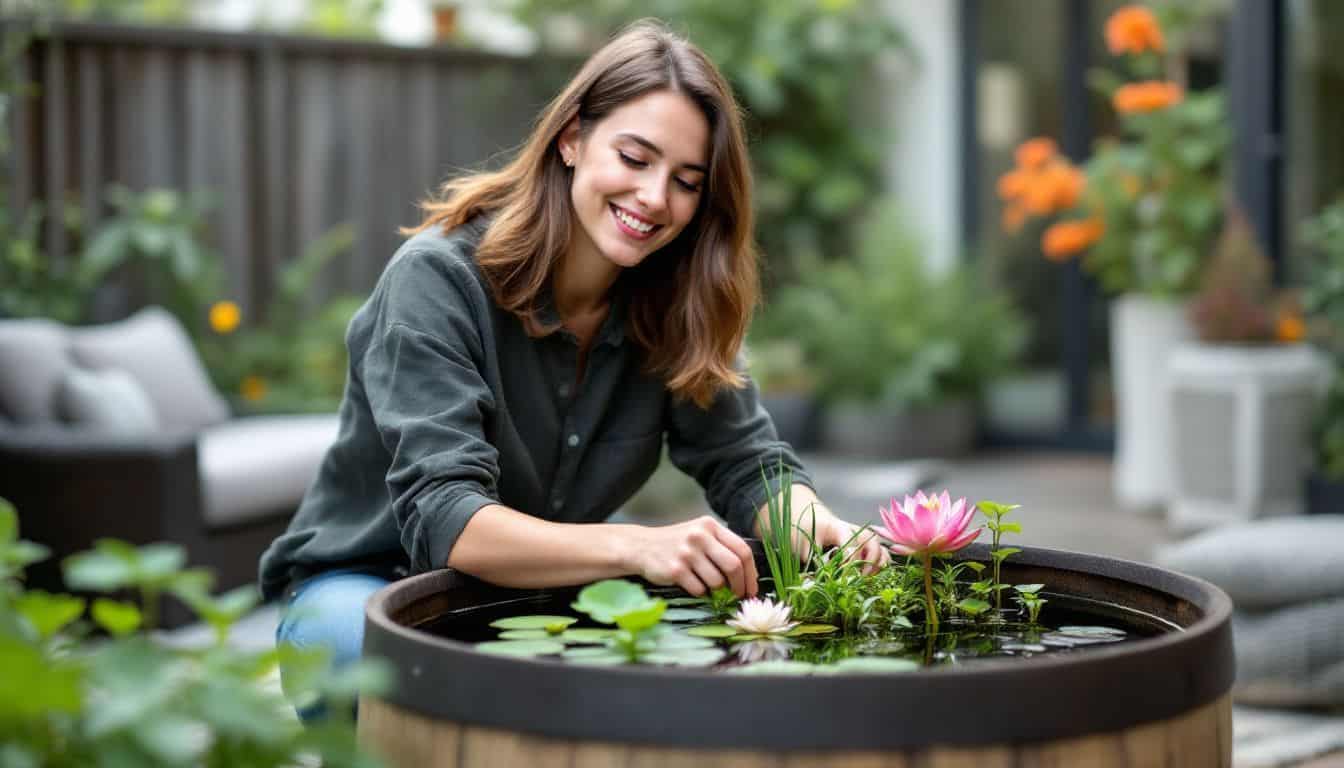
Water gardens come in all shapes and sizes. Here are the types of containers you can use to create your own aquatic oasis:
- Teacups: Tiny but mighty! These cute containers are perfect for small spaces like balconies or tabletops. Add a mini water lily and – instant charm.
- Half Whiskey Barrels: These rustic beauties add a country touch. Just make sure to buy water garden pond liners online to keep those wood toxins away.
- Ceramic Pots: Elegant and versatile, these come in countless colors and styles. They’re great for showing off floating plants like water lettuce.
- Plastic Tubs: Affordable and lightweight, these are ideal for beginners. They’re easy to move if you want to change their location.
- Metal Troughs: Got a modern style? These sleek containers fit right in. Just make sure they’re coated to prevent rust.
- Glass Bowls: Perfect for indoor water gardens. They show all the underwater action – roots, fish, everything.
- Concrete Basins: Strong and long-lasting, these are great for larger outdoor water gardens. They can support heavier plants and fish.
- Repurposed Items: Old sinks, bathtubs, or even wheelbarrows can make unique water gardens. It’s all about being creative!
Water Pump Functions
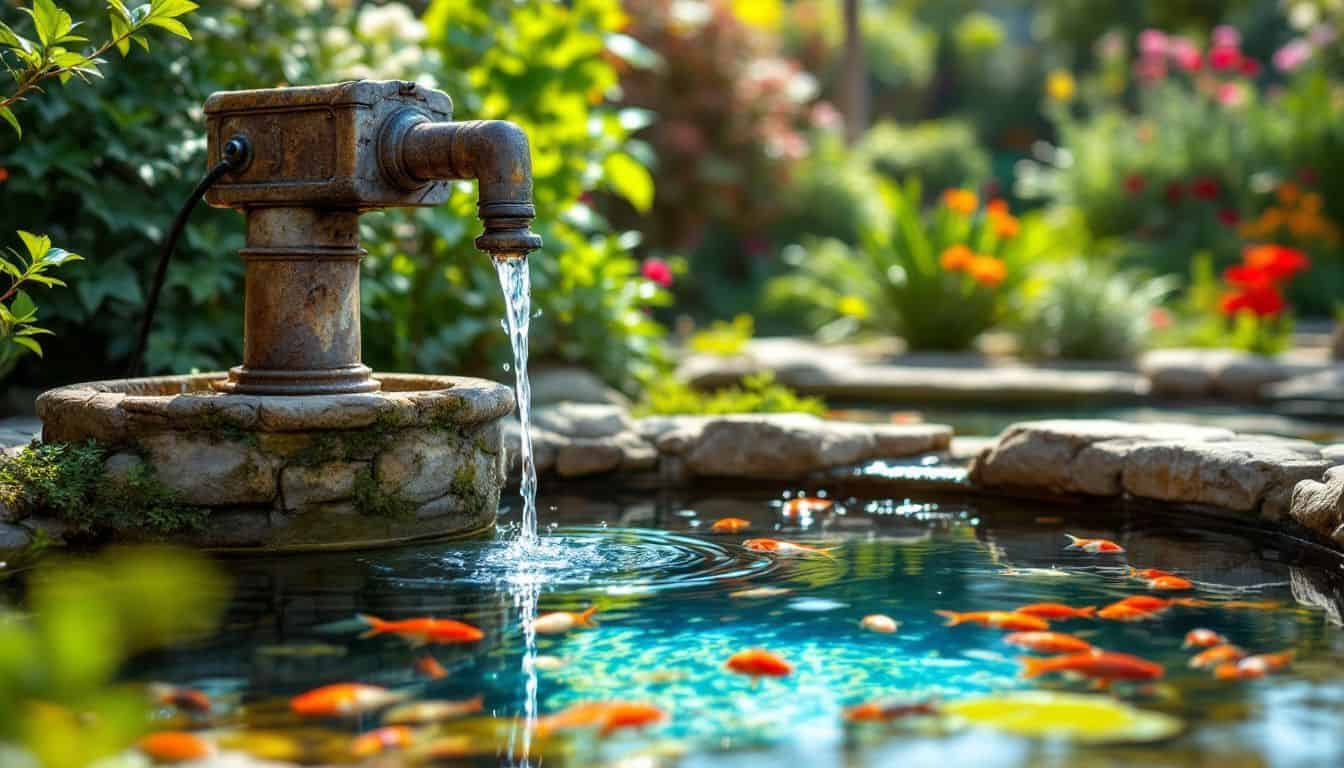
Moving from container types, let’s dive into the heart of your water garden: pumps. These little powerhouses do more than just move water around. They’re the life-givers of your aquatic oasis.
Pumps are the unsung heroes in water gardens. They keep nutrients and oxygen flowing, which is crucial for happy plants and fish. Without them, your garden might turn into a stinky swamp.
Trust me, I’ve learned this the hard way! Pumps also help keep those pesky mosquitoes at bay. No one wants a bug-infested garden party, right? The key is to pick a pump that fits your garden’s size and needs.
Too small, and it won’t do the job. Too big, and you’ll have a mini-tsunami on your hands!
A good pump is like a good heart – it keeps everything flowing smoothly.
Water Feature Designs

Water feature designs can jazz up any backyard. From bubbling fountains to cascading waterfalls, the options are endless. Ponds add a natural touch, while water bowls create a modern vibe.
Fountains come in all shapes and sizes – some spray high, others trickle gently. The key is picking a design that fits your space and style.
Your water feature can do more than look pretty. It can mask annoying noises like traffic or loud neighbors. The sound of flowing water is super relaxing. It’s like having your own mini-spa right outside! Plus, moving water keeps things fresh and prevents stagnation.
So go ahead, dream big with your water garden design. It’ll be your own slice of paradise.
Ideal Plants for a Water Garden
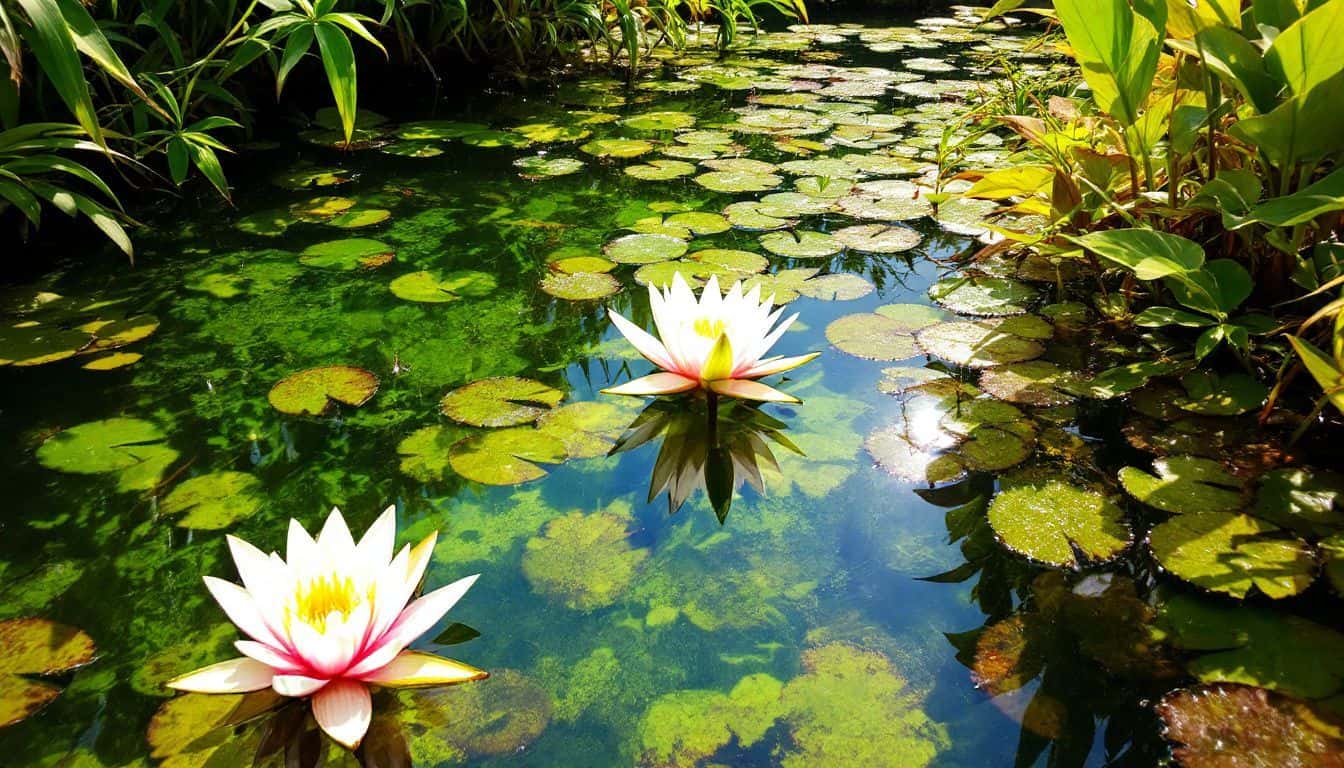
Plants can make or break your water garden. They’re not just pretty—they work hard too! From floating beauties to underwater cleaners, each type plays a key role. Want to know which ones will turn your pond into a slice of paradise? Keep reading….
Benefits of Floating Plants
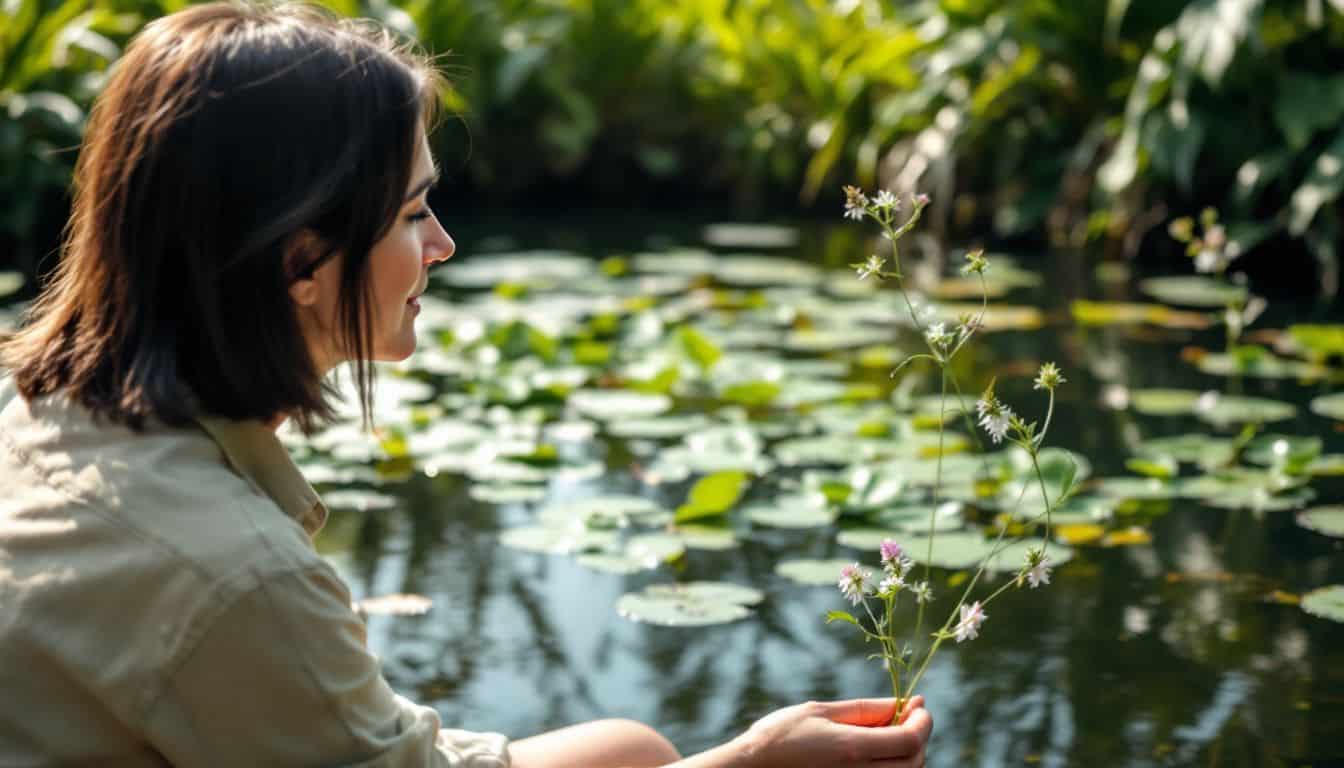
Floating plants are the superheroes of water gardens. They’re not just pretty faces – these aquatic wonders pack a punch! They spread out on the water’s surface, creating a lush, green carpet.
This natural shade keeps algae at bay, making your pond look cleaner and healthier. Plus, these plants are hungry little fellows. They gobble up nutrients from the water, starving out pesky algae even more.
Let’s talk options, ladies. Water lilies are the classic choice, with their stunning blooms. But don’t overlook duckweed or water lettuce – they’re easy to grow and spread quickly.
Just a heads up: some floating plants can be a bit too eager to take over. Check your local rules before adding water hyacinth or spatterdock. Trust me, I learned this the hard way when my neighbor’s pond turned into a mini-jungle overnight!
Role of Oxygenating Plants
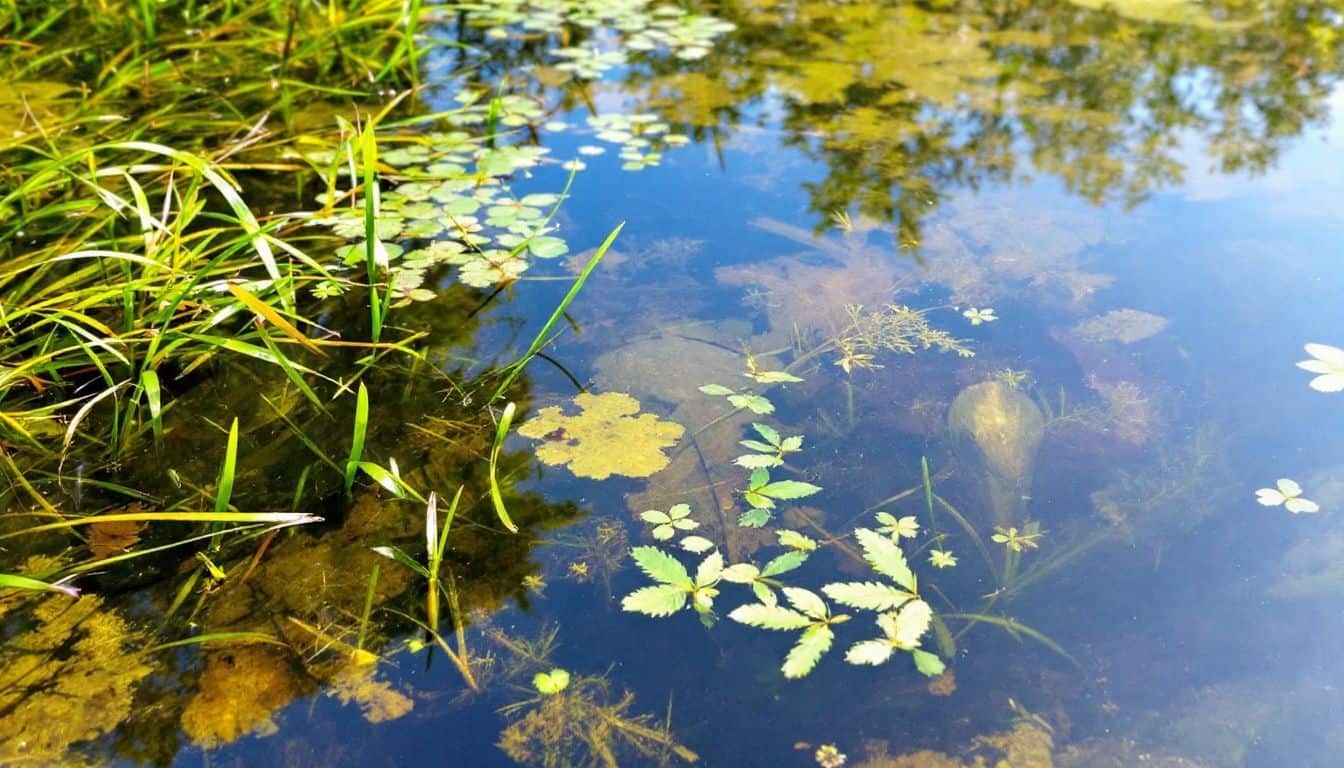
Floating plants are great, but oxygenating plants are the real MVPs of water gardens. These underwater heroes work hard to keep your pond healthy. They make oxygen through photosynthesis, just like their above-water cousins.
But that’s not all they do!
Oxygenating plants are nature’s filters. They suck up extra nutrients from the water, keeping algae in check. For every square meter of pond surface, you’ll want about three of these plants.
So, if you’ve got a 2-meter by 2-meter pond, aim for 12 oxygenating plants. Some top picks are Hornwort, Eelgrass, and Anacharis. These green machines will help your fish breathe easy and keep your water crystal clear.
Oxygenating plants are the lungs of your water garden, breathing life into every drop.
Types of Marginal Plants
Oxygenating plants keep your water clean, but marginal plants add beauty to your pond’s edges. These plants grow in shallow water or moist soil around the pond. Here’s a list of popular marginal plants for your water garden:
- Cattails: These tall, grass-like plants with fuzzy brown tops are a classic pond look. They grow fast and help filter water.
- Arrowhead: Named for its arrow-shaped leaves, this plant has pretty white flowers. It’s great for small ponds and attracts butterflies.
- Pickerelweed: This tough plant has heart-shaped leaves and purple flower spikes. It blooms all summer and provides cover for fish.
- Water plantain: With its broad leaves and tiny white flowers, this plant adds texture to pond edges. It’s easy to grow and spreads quickly.
- Sweet flag: This grass-like plant has a sweet scent when crushed. It’s perfect for pond borders and helps stop soil erosion.
- Iris: These showy flowers come in many colors. They love wet feet and add a pop of color to your pond’s edge.
- Marsh marigold: Bright yellow flowers bloom early in spring. This plant likes cool, shady spots around your pond.
- Cardinal flower: Its bright red blooms attract hummingbirds. It grows well in wet soil and partial shade.
Importance of Bog Plants
Bog plants are the unsung heroes of water gardens. They’re not just pretty faces – these tough plants work hard to keep your garden healthy. Water iris, rose pogonia, and pitcher plants thrive in wet soil near the water’s edge.
They act like nature’s filters, soaking up extra nutrients that could harm your fish or cause algae blooms. I’ve seen firsthand how adding bog plants can transform a murky pond into a crystal-clear oasis.
But that’s not all! Bog plants create a lush, green border around your water feature. They attract helpful bugs and provide hiding spots for small critters. Plus, they’re low-maintenance – perfect for busy gardeners.
Taro, canna lilies, and irises add pops of color and texture to your garden’s design. It’s like having a mini-wetland right in your backyard!
Integrating Fish into a Water Garden
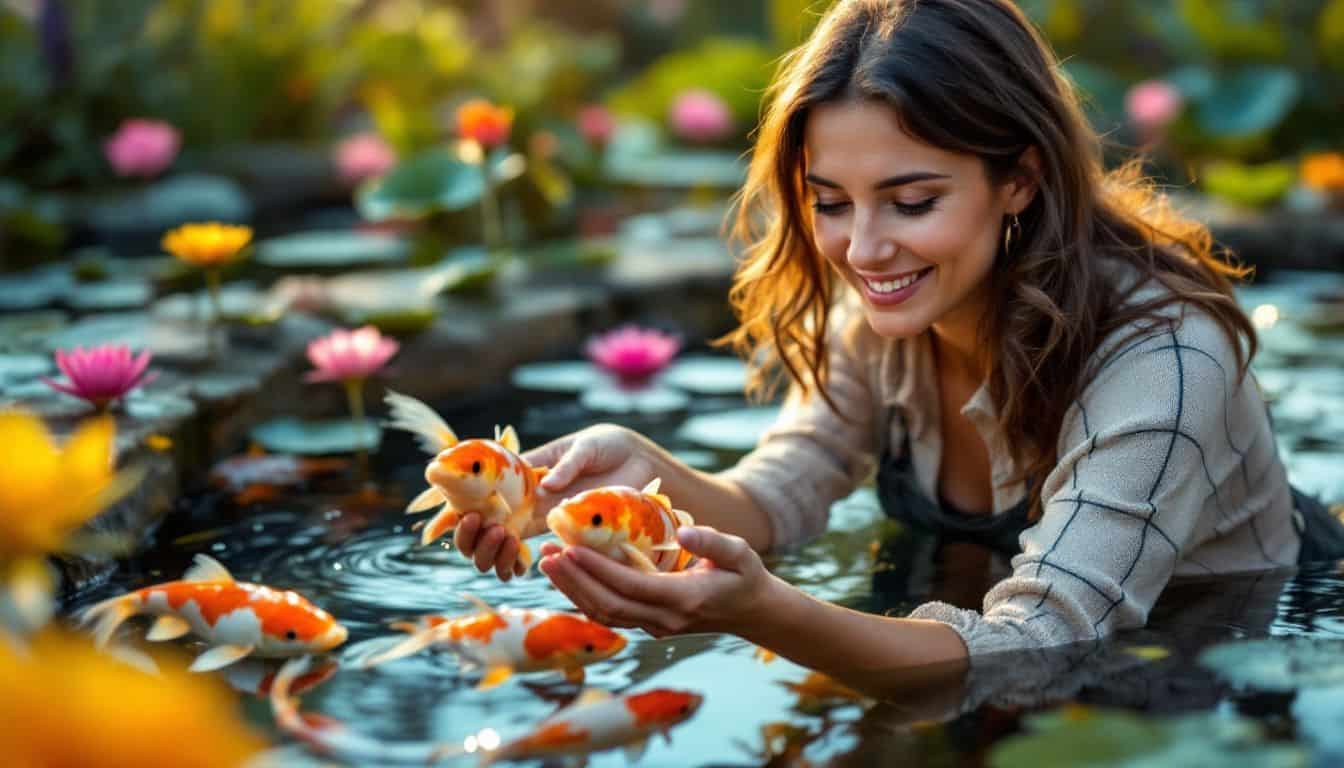
Adding fish to your water garden brings it to life! They add color, movement, and a touch of magic. But hold your horses – there’s more to it than just tossing them in.
Suitable Fish for Water Gardens
Water gardens add life and beauty to your backyard. Let’s check out some fish that do well in these water spots.
- Goldfish: These tough swimmers come in different colors and patterns. They’re easy to take care of and can live up to 20 years in a good pond.
- Koi: Known for their bright colors, koi are a popular pick. They get big and can live for many years, so they’re a long-term addition.
- Mosquito Fish: Small but tough, these fish eat mosquito larvae. They help keep your water garden free from annoying bugs.
- Rosy Red Minnows: These little fish are great for smaller ponds. They’re lively and fun to see as they zip around.
- Golden Orfe: With their bright orange color, these fish add a splash of color. They’re also good at eating insects.
- Shubunkins: These multi-colored fish are like fancy goldfish. They’re strong and can handle different water temps.
- Weather Loaches: These bottom-dwellers help keep your pond clean. They’re also fun to watch as they squirm through the water.
Fish need at least 15 inches of water depth to do well. Now, let’s see how to add these finned friends to their new home.
How to Acclimate Fish
Adding fish to your water garden is exciting! But hold your horses – you need to acclimate them first. Let’s dive into the steps to make sure your finned friends feel right at home:
- Choose your method: You’ve got three main options – Floating Bag, Bucket, or Drip. Each has its perks, so pick what works best for you.
- Prep the fish: Keep them in their transport bag or container. Don’t rush this part!
- Temperature match: Float the bag in your pond for about 15 minutes. This helps the water temps even out.
- Mix it up: For the Floating Bag Method, slowly add pond water to the bag over an hour. This gets the fish used to the new water chemistry.
- Take it slow: Don’t dump the fish in right away. Give them time to adjust to their new digs.
- Watch and wait: Keep an eye on your new buddies for the first few days. Look for any odd behavior or signs of stress.
- Feed with care: Wait a day before offering food. Start with small amounts to avoid overfeeding.
- Maintain water quality: Keep tabs on ammonia and nitrite levels. Your new fish might throw things off balance at first.
Constructing a Water Garden
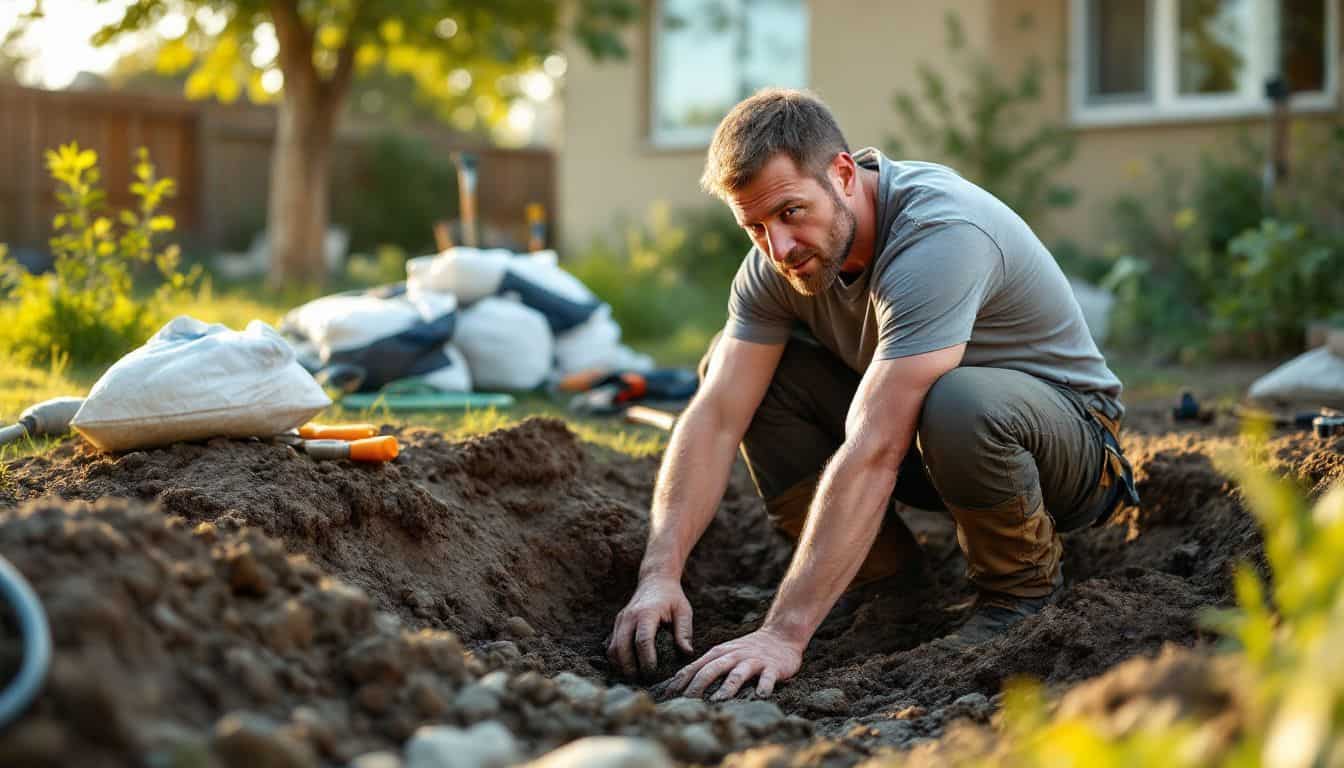
Ready to dive into water garden construction? It’s simpler than you might think! With a few key steps, you’ll transform your backyard into a tranquil oasis – complete with bubbling fountains and colorful fish.
Choosing a Suitable Location
Picking the perfect spot for your water garden is key. You’ll want a place that gets plenty of sun – at least six hours daily. This helps your plants thrive and keeps the water warm for fish.
Steer clear of areas near big trees or bushes. Why? Those leafy giants drop a ton of debris, making your garden a mess. Plus, roots can damage your pond liner over time.
Think about the view from your house too. A water garden can be a real eye-catcher, so put it where you can enjoy it most. Maybe that’s right outside your living room window or near your patio.
Just make sure it’s easy to access for maintenance. And don’t forget about power sources – you’ll need electricity for pumps and filters. With the right spot, your water garden will be a backyard oasis in no time!
Deciding on Size and Type
After picking the perfect spot, it’s time to think about size and type. Your water garden can be as small as a whiskey barrel or as big as your backyard allows. I once started with a tiny container on my patio – it was just big enough for a few water lilies and a bubbler.
But oh boy, did it spark joy!
The type of water garden you choose depends on your space and goals. Do you want a formal look with straight lines? Or a natural pond that blends into your landscape? Tabletop designs are great for small spaces, while large installations can become the centerpiece of your yard.
Keep in mind – bigger isn’t always better. A small, well-planned water garden can be just as stunning as a large one. And it’s easier to maintain, too!
Installing Filtration Systems
Filtration systems are the heart of a healthy water garden. They keep your aquatic paradise clean and your fish happy.
- Choose the right size: Pick a filter that can handle your pond’s volume. A good rule of thumb is to get one that can process the entire pond in two hours.
- Select your filter type: Mechanical filters trap debris, while biological filters break down waste. Many systems combine both for best results.
- Place it wisely: Install your filter where it’s easy to access for cleaning. Near the pond edge works well, but you can hide it with plants for a natural look.
- Connect the plumbing: Use flexible tubing to link your pump to the filter. Make sure all connections are tight to prevent leaks.
- Add filter media: This is what does the cleaning work. Options include foam, bio-balls, or ceramic rings. Layer them for maximum efficiency.
- Set up a skimmer: This catches floating debris before it sinks. It’s like a pool skimmer, but for your pond.
- Install a UV clarifier: This zaps algae, keeping your water crystal clear. It’s optional but can make a big difference in water quality.
- Test the system: Once everything’s hooked up, run it for a few hours. Check for leaks and adjust the flow if needed.
Now that we’ve covered filtration, let’s dive into the fun part – adding plants to your water garden.
Water Garden Maintenance
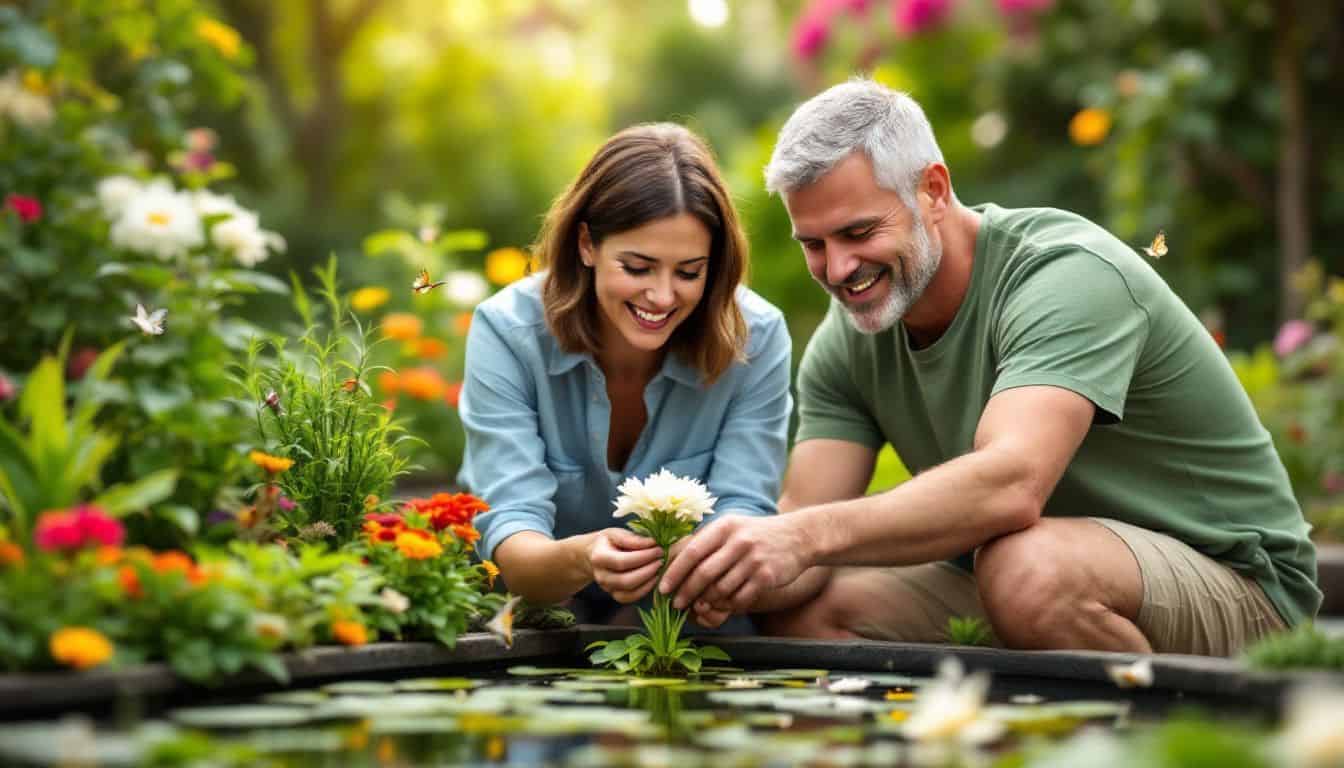
Water garden maintenance keeps your backyard oasis thriving. It’s not all work, though – there’s a splash of fun too! Want to know more about keeping your aquatic paradise in tip-top shape? Keep reading!
Handling Debris and Plant Residues
Keeping your water garden clean is key to a happy oasis. Grab a skimmer net and scoop out leaves, twigs, and other gunk daily. This quick task stops waste from sinking and making your pond stinky.
Don’t forget about dead plant bits! Snip off faded flowers and yellowing leaves to keep your aquatic plants looking fresh.
A clean pond isn’t just pretty – it’s healthier for your fish and plants too. Less debris means fewer algae problems and better water quality. Plus, your pump won’t have to work as hard.
So, roll up those sleeves and get scooping! Next up, let’s chat about helping your water garden plants thrive.
Promoting Healthy Plant Growth
After clearing out debris, it’s time to focus on your plants. Healthy growth is essential for a thriving water garden. First, make sure your plants get enough light. Most aquatic plants love the sun, but some prefer shade.
Check the needs of each species. Then, feed them right. Use special fertilizer tabs for water plants. Don’t overdo it, though! Too much food can lead to algae blooms.
Pruning is essential for plant health. Snip off dead or yellowing leaves regularly. This keeps plants looking good and prevents rotting matter from fouling the water. Also, divide overcrowded plants every few years.
This gives them room to grow and keeps your garden looking its best. A healthy plant garden means privacy in your garden and a beautiful oasis for you to enjoy.
Seasonal Care and Preparation for Winter
Promoting healthy plant growth sets the stage for winter prep. As temperatures drop, your water garden needs special care to thrive year-round. Here’s how to get your aquatic oasis ready for the cold months:
- Trim back plants: Cut marginal and floating plants to about 2 inches above the water line. This prevents decay and keeps your pond tidy.
- Move tender plants deeper: Relocate tropical lilies and other non-hardy plants to the deepest part of your pond. This helps protect them from freezing.
- Add a pond de-icer: Install a floating heater to keep a small area ice-free. This allows toxic gases to escape and helps fish breathe.
- Remove fallen leaves: Use a net to scoop out debris regularly. Decaying matter can harm water quality and fish health.
- Reduce feeding: As water temps cool, fish metabolism slows. Cut back on food to avoid uneaten pellets polluting the water.
- Check filtration: Clean or replace filters before winter. Good filtration helps maintain water quality during dormant months.
- Consider a pond cover: A net over your pond keeps out leaves and protects fish from predators like herons.
- Monitor water levels: Top off the pond as needed. Proper depth helps insulate fish and plants from extreme cold.
Controlling Algae and Water Quality
Algae can be a real pain in water gardens. It turns your oasis green and slimy – yuck! But don’t worry, there are easy fixes. Add more floating plants like water lilies or duckweed.
They shade the water and starve algae of sunlight. You can also toss in some good bacteria or algae-eating fish. These little helpers munch away at the green stuff.
Clean water is key for happy fish. Keep an eye on oxygen levels – they change with weather and time of day. Remove dead leaves and other gunk regularly. This stops harmful stuff from building up.
A simple water test kit helps you spot problems early. With a bit of care, your water garden will stay crystal clear and full of life!
Addressing Common Challenges
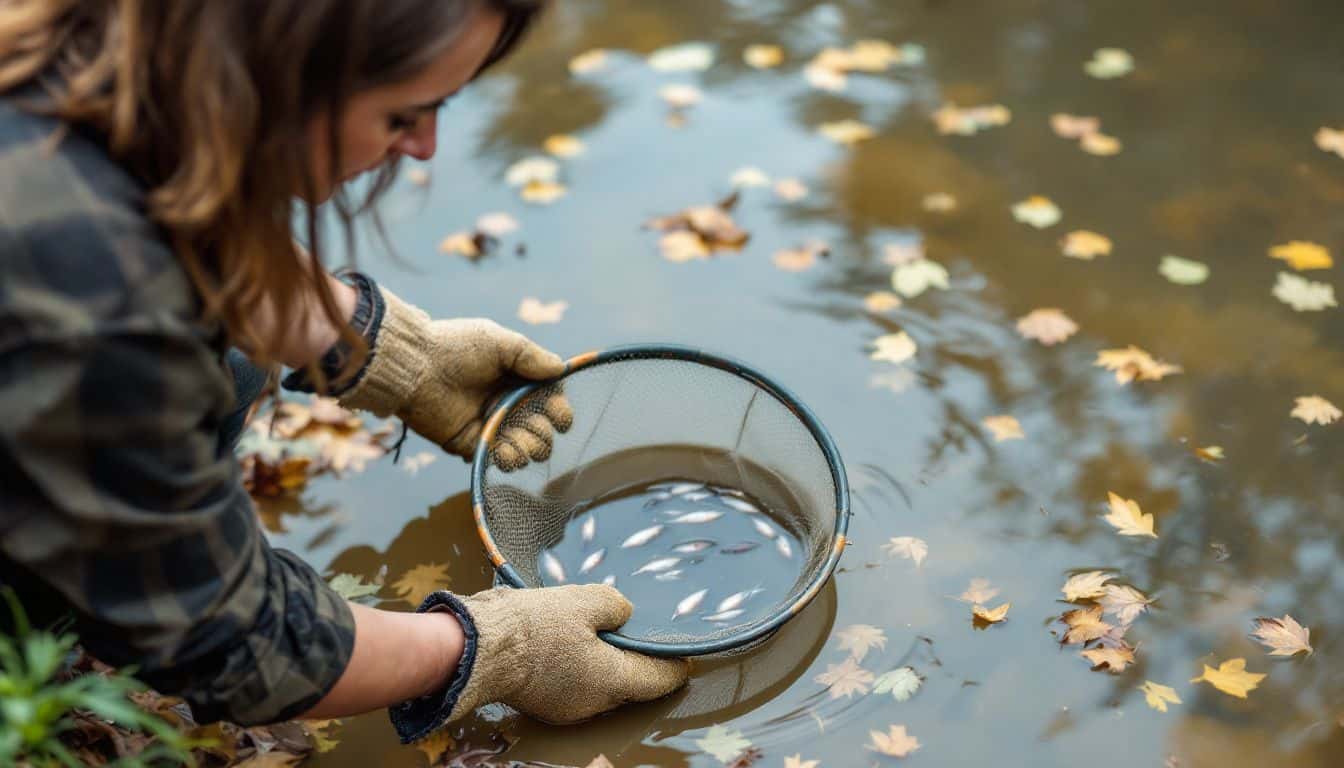
Water gardens can be tricky sometimes. Fish might have babies, critters might sneak in, and your finned friends could get sick. But don’t worry – we’ve got your back!
Managing Fish Reproduction
Fish in your water garden can multiply fast! This can lead to overcrowding and poor water quality. To keep things in check, you might need to separate male and female fish during breeding season.
Another trick is to remove extra eggs or fry (baby fish) from the pond. Some folks even add predator fish to eat the extras. But be careful – these hungry helpers might snack on your prized koi too!
I once had a goldfish pond that turned into a fish city overnight. It was like a fishy baby boom! I learned the hard way that managing fish numbers is key. Now, I keep an eye on my finned friends and their frisky behavior.
It’s all about balance in your aquatic garden. Too many fish can mess with your pond’s ecosystem and create a ‘dead zone’ where nothing thrives. So, keep those fish numbers in check for a healthy, happy water garden.
Handling Predators and Nuisances
Predators and pests can turn your peaceful water garden into a battleground. Let’s dive into some smart ways to keep your aquatic oasis safe and sound.
- Netting: Throw a net over your pond to keep herons at bay. It’s like giving your fish a safety blanket!
- Decoys: Place fake predators around your pond. A plastic owl might just fool those pesky raccoons.
- Motion-activated sprinklers: These gadgets will give unwanted visitors a surprise shower. It’s hilarious and effective!
- Deep zones: Create areas at least 3 feet deep in your pond. Fish can hide from aerial attackers in these underwater safe spots.
- Pond lighting: Install some lights around your water garden. They’ll scare off nocturnal critters and look pretty too.
- Natural barriers: Plant thorny bushes or dense shrubs near your pond. These green guards will make it tough for predators to get close.
- Floating plants: Add water lilies or other floating plants to your pond. They give fish cover and make it harder for birds to spot their next meal.
- Regular maintenance: Keep your pond area clean and tidy. A messy space attracts more pests and makes it easier for predators to hide.
- Ultrasonic devices: These gizmos emit high-frequency sounds that drive away pests. Humans can’t hear them, but critters sure can!
- Fish caves: Add some hollow logs or PVC pipes to your pond. They’re perfect hideouts for your finned friends when danger lurks.
Preventing and Treating Fish Diseases
Fish diseases can wreak havoc in your water garden. Let’s dive into some practical ways to keep your finned friends healthy and happy.
- Regular check-ups: Peek at your fish daily. Look for odd swimming, appetite changes, or weird spots.
- Clean water is key: Use a good filter and change 10-15% of the water weekly. Happy fish need clean digs!
- Quarantine new arrivals: New fish? Give ’em a separate home for 2-4 weeks. It’s like a fish spa vacation!
- Balanced diet: Feed your fish a mix of foods. Variety is the spice of life, even for koi!
- Stress-free zone: Keep water temp steady and avoid sudden changes. Fish like chill vibes too.
- Vax it up: Vaccinate fish before they meet pathogens. It’s like fish flu shots!
- Watch that crowd: Don’t overstock. Too many fish in one pond is a recipe for trouble.
- Quick action: See something fishy? Act fast! Early treatment can save the day.
- Natural helpers: Add plants like azolla. They’re nature’s water purifiers.
- Pro help: Got a tricky case? Don’t be shy to call a fish doc. They’re the real experts!
People Also Ask
What’s a water garden, and how does it differ from a regular garden?
A water garden is a backyard oasis with water features like ponds or fountains. It’s not your average veggie patch! These aquatic gardens host fish, plants, and other water-loving critters. Think of it as a mini ecosystem in your yard.
How do I keep algae under control in my pond?
Algae control is a big deal in water gardens. Use biofiltration and add some mosquito ferns. These little guys gobble up excess nutrients that algae love. Plus, they look pretty cool floating on the surface!
Can I have fish in my water garden?
You bet! Pond fish like koi are popular choices. They’re like swimming jewels in your backyard. Just remember, fish produce waste that decomposes into nitrogen. That’s great for plants but can lead to algae if not managed.
What plants work well in a water garden?
Aquatic plants are the stars here. Try some hardy perennials that can handle frost. Chinese gardens often use lotus flowers. They’re beautiful and help with pest control by shading the water.
How do I deal with freezing temperatures in winter?
Frost can be a real party pooper for your water garden. Create a deep shelf in your pond where fish can hang out when it’s cold. Some gardeners use heaters, but good design can often do the trick.
Are there famous water gardens I can use for inspiration?
Oh yeah! Check out Villa d’Este in Tivoli, Italy. It’s like the granddaddy of water gardens. Or look up Nanfang Caomu Zhuang in China. These places show how water can transform garden designs into something magical.
References
https://amencornerponds.com/water-garden/ (2023-08-10)
https://dennis7dees.com/how-to-create-a-water-garden/ (2024-05-28)
https://extension.psu.edu/tips-for-creating-a-water-garden
https://www.fishlore.com/acclimating-tropicalfish.htm (2019-08-12)
https://aquascapes.com/diy-water-garden-construction-guide/
https://www.masterclass.com/articles/water-garden-plants (2021-10-28)
https://bluestem.ca/perennials/create-a-serene-water-garden-oasis-your-mini-ecosystem-guide/
https://extension.okstate.edu/fact-sheets/water-gardens-a-low-management-approach.html
https://www.lifeinthefingerlakes.com/an-oasis-in-your-own-backyard/
https://www.canr.msu.edu/news/water_gardeners_beware_keep_nature_and_your_landscape_separate (2017-06-27)
